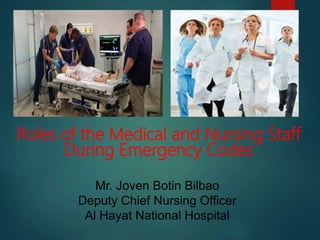
Roles of the medical and nursing staff during emergency codes
- 1. Roles of the Medical and Nursing Staff During Emergency Codes Mr. Joven Botin Bilbao Deputy Chief Nursing Officer Al Hayat National Hospital
- 3. CODE BLUE TEAM Trained patient care providers who perform resuscitation on any person who sustains Cardiopulmonary arrest Respiratory arrest Airway problem Train providers: Doctor Nurse respiratory Therapist Support Personnel
- 4. CODE BLUE ACTIVATION All employees must be educated to activate Code Blue response in the event of Cardiac arrest Respiratory arrest Activate Code Blue Response by Calling Hospital Emergency Operator Provide Information: Patient location, Adult/Pediatric/Obgyne Hospital Emergency Operator will activate response when notified of Code Blue event Announce overhead the location of the code event Example: attention! Code Blue, ER, Pedia ( 3 times )
- 5. CODE BLUE MEMBERS Physician Intensivist, Anesthesia Cardiologist/Internal Medicine Pediatric attending or senior resident (Pedia patient) Obgyne Attending or Senior resident (Obgyne/pregnant Patient) Nurse Intensive Care Unit Nurse Emergency Nurse Unit Nurse Nurse Supervisor Respiratory Therapist Security Guard
- 6. Requirements for the member of the Code Blue Team Resuscitative Certification Advance Cardiac Life Support (ACLS) for adult code blue Pediatric Advance Life Support (PALS) for pediatric code blue Neonatal Resuscitation Program (NRP) For neonatal code blue
- 7. ROLE OF THE TEAM MEMBERS PHYSICIAN Team Leader: direct overall patient care Manage the Code Medication Defibrillation Other procedures: Intubation, compressions Evaluate Code Blue procedures Effectiveness of Chest Compression Effectiveness of assisted respirations Rhythm/pulse check Document in the medical record
- 8. ROLE OF THE TEAM MEMBERS ICU/ER NURSE Maintains airway/oxygenation/ventilation Applies monitor leads/defibrillator pads Starts Intravenous access Administer medications Administers Electrical Shock (ACLS trained) Assist with intubation procedures
- 9. ROLE OF THE TEAM MEMBERS PRIMARY NURSE Activate code blue team Bring Emergency Resuscitation Cart Place backboard under patient Initiate 2 man Cardio Pulmonary Resuscitation Administer ventilations with 100% O2 with Bag/valve/mask Attach Electro cardiogram leads Attach “hands off” defibrillator pads Ensure patient Intra Venous access Prepare suction Obtain supplies from CPR Cart/Ward Stock
- 10. ROLE OF THE TEAM MEMBERS NURSE SUPERVISOR Record events on CPR record Completes CPR record Assign additional nurse if necessary Arrange for possible transfer to Critical care Unit
- 11. ROLE OF THE TEAM MEMBERS RESPIRATORY THERAPIST Maintains airway and oxygenation/ventilation Assist with intubation procedures Limit the audience and crowd control during the event of code blue. ROLE OF THE TEAM MEMBERS SECURITY GUARD
- 13. Rapid Response Team (RRT Rapid Response Teams is a designated group of healthcare clinicians who can be assembled quickly to deliver critical care expertise in response to grave clinical deterioration of a patient located outside a critical care unit. RRTs provide early recognition & response to signs of patient's deterioration
- 14. Goals of RRT To save patient lives & eventually improve quality of hospital care & improve patient safety Increase early intervention & stabilization to prevent clinical deterioration on any individual prior to the event of cardiopulmonary arrest or other life threatening health event Decrease the number of cardiopulmonary arrests that occur outside the ICU & ER department Increase patient, family & staff satisfaction Decrease hospital mortality rate Reduce severe postoperative adverse events
- 15. RRT Member Primary nurse (who activated RRT) ICU nurse (ACLS for adult) (PALS for pedia) Nursing supervisor on duty Respiratory therapist Intensivist resident on duty Pediatric specialist on duty
- 16. Key features of the RRT There are three key features of the team members: They must be available to respond immediately when called, and not be constrained by competing responsibilities They must be onsite and accessible They must have the critical care skills necessary to assess and respond
- 21. How to activate RRT ? Attending nurse / doctor dials 0 and connect to the supervisor on duty. Supervisor will contact the member of the Rapid response Team Five minutes is the response time for the group to arrive, 15 minutes is the maximum time for the team arrival
- 22. Role of unit nurse in RRT Assesses patient, check vital signs Identifies crisis, refer patient’s condition following SBAR guidelines Call for help Stays with the patient Helps patient into comfortable position Shares pertinent information with RRT members upon their arrival Bring crash cart to the site
- 23. Role of Nursing Supervisor Responds immediately to request for activation of the rapid response and coordinate with the member of the RRT team. Assess situation especially with regards to activities of nursing staff & provides additional assistance if needed Calls relevant consultants as requested by Code purple team leader Coordinated transfer of patient to ICU if the need arises Undertakes recording & documentation
- 24. Role of ICU nurse Responds to assist ICU resident on duty / ICU Specialist on duty to provide care needed. Prepares inotropes as needed to transfuse with infusion pump. Monitor the patient until stable and accompany patient for transfer to the critical area.
- 25. Role of Respiratory therapist Assists the ICU resident / Specialist in managing airway Provides portable ventilator from ICU if the need arises Assists in transferring of the patient to ICU
- 26. Role of ICU resident on duty Assess the clinical condition of the patient Stabilize the patient’s condition Provides airway management, maintains oxygenation Provides ventilation manually or by the use of portable ventilator Assists in transfer to ICU if needed Assists in inter-hospital transfer if needed Assist with the mobilization of resources required to further support the patient Decides about the transfer of patient to higher level of care Educates & support nursing & medical staff Conducts a debriefing session after the RRT for the team
